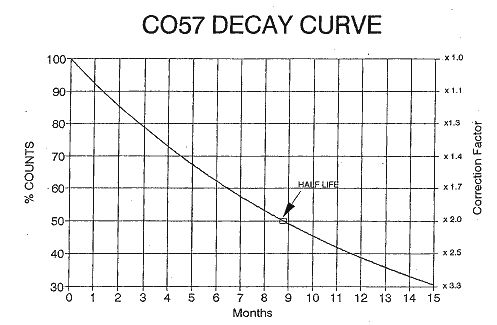

Environmental
Monitoring, Safety and EH&S Instrumentation
|
|
||||
Cobalt vs Cadmium |
||||
|
Co-57 and Cd-109 radioactive materials are both used as excitation sources in portable x-ray fluorescence (XRF) systems for measurement of lead in paint. In an x-ray fluorescence process, the source emits radiation of specific energy. This radiation dislodges the electrons of lead from their atoms resulting in production of characteristic x-rays of lead that can then be detected by the XRF's detector. To do this, the radiation energy of the source must be greater than the binding energy of the electron. Otherwise, the electron is not dislodged and no x-ray fluorescence is produced. For evaluating a system's performance, one might consider "source efficiency" or simply the measurement time for a given condition and compare that to another device's performance for the same set of conditions. On the one hand, it may be misleading to compare a set time for a Co-57 source and claim it will be larger than a Cd-109 source at some time in future without taking the source efficiency into consideration. An understanding of the overall system performance as it relates to source efficiency can be explained as follows: Even though both Co-57 & Cd-109 sources are used in XRF systems, their relative efficiency for production of x-ray fluorescence of lead differs due to their inherent radiation energies.
The Lead atom has several x-ray characteristic energy lines. The radiation energies (Excitation Potential) required for inducing x-ray fluorescence of these lead lines are:
As one can observe, Co-57 gamma ray energies (122 and 136 Kev) are more efficient (at least 10 times) than those of Cd-109 (22-26 Kev and 88 Kev) source for production of K-shell lead x-rays of lead. As stated above, this is because the excitation energy has to be greater than the fluorescent energy. Where, Cd-109 source is a more efficient source for L-shell x-ray induction. Considering that the HUD Chapter 7 along with EPA's Methodology for PCS document clearly indicate the effectiveness of the K-shell x-rays for lead in paint measurements and warn against the reliance on the L-shell measurements, Co-57 source is ideal for lead in paint measurement application. The half-life of Co-57 is about 272 days (9 months) and around 460 days (1.27 years) for Cd-109. This means that after each half-life, a given measurement time will double. The measurement time for a given condition of paint (lead content, Action level, etc.) is a function of several factors. These factors are source efficiency for production of lead x-rays, strength of the source, detector efficiency, and algorithm.
|
||||
 |
||||
|
Looking only at half-life of the two sources, it is obvious that a 5-second measurement time will be 15 seconds for a Co-57 and 9 seconds for a Cd-109 after one year. This has no relevance to actual performance of the systems that use these sources. As mentioned above, comparison of measurement times of two XRF systems must be made based on their actual performance on the same sample and for the same set of conditions not the theoretical source decay curves. This means one should use both systems for a given lead paint concentration, compare the actual measurement times, and then use the source decay half-life for future extrapolations. For a real-life paint condition, a Co-57 system will have a much shorter measurement time based on its source efficiency for production of K-shell lead x-rays than a Cd-109 source device. Cd-109 does not have as much high-energy radiation as a Co-57 source to generate K-shell X-rays therefore, it has to rely on both L-shell for surface lead and its inefficient K-shell for deep lead. This will lead to a longer measurement time in the field where paint matrix is convoluted with many other elements and the lead paint layer is deep under several other layers of paint. PROTEC Instruments' RMD LPA-1 analyzer is a true K-shell XRF spectrum analyzer that is capable of measuring lead in paint without reliance on the L-shell data. L-shell x-rays could be influenced by paint layers on top and also be interfered with by commonly present elements in paint such as Ba, Zn, Br, As, Se, etc. The recommended source change period for a 12 mCi, LPA-1 XRF analyzer is 15 months. As most inspectors in the filed have experienced, the PROTEC Instruments' LPA-1 XRF analyzer is the fastest, most productive system for lead in paint inspection in the market. This is mostly due to the significant feature of the LPXpro system, Quick operation mode, and its ability to drive to a 95% conclusion in the shortest possible time, without any operator involvement, based on published performance characteristics In conclusion --and when overall system performance is the objective -- a Co-57 source provides excellent system performance when comparing apples to apples. |
||||
|